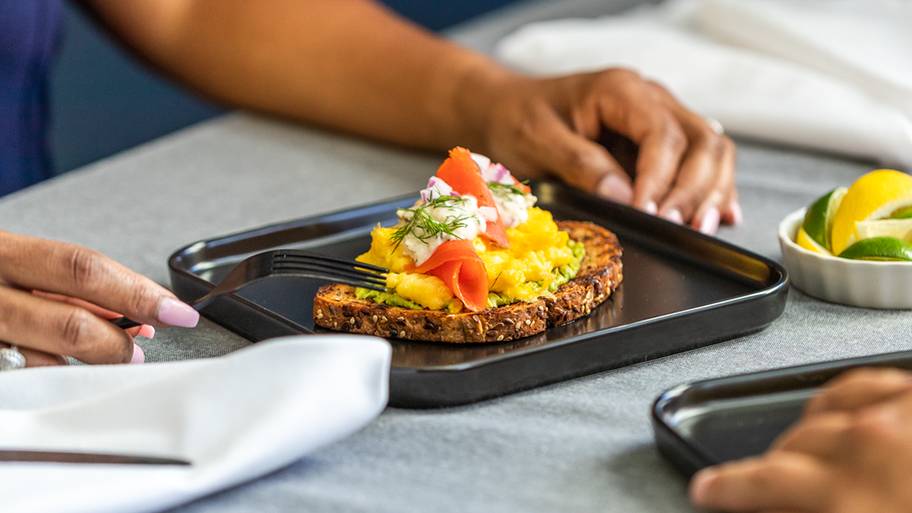This article was originally posted July 2020, and updated on January 5.
Connecting Mind, Body, and… Ocean Wellness?
I firmly believe that you are what you eat—that food has a considerable impact on every aspect of our life including hormonal balance, energy production, productivity, and general well-being. However, this sentiment has a broader impact that expands beyond one’s self.
If you make sustainable food choices that maximize nutritional value and minimize environmental impact, you are taking care of not only your health but also the health of our planet. We should challenge ourselves to ask daily: “how can my choices help to recreate the world to a fuller and better life?”
Around 33% of the world’s fish stocks are overfished to date, and there is a growing need for seafood lovers to contribute to our ocean’s health through everyday choices. As a nutrition expert, that means making health-conscious and eco-conscious seafood purchases. The MSC blue fish label first caught my attention when I moved to the United States years ago and introduced a straightforward way to choose certified sustainable seafood at the grocery store and in restaurants.
When I purchase seafood with the blue fish label, I know I'm supporting fisheries and brands committed to making certified sustainable wild-caught seafood available across North America. These characteristics help to build a big blue future for our ocean—one where it can continue to provide livelihoods for countless fishermen, feed billions who depend on seafood as their primary source of protein and regulate our climate through the absorption of CO2.
Why Not Stop Consuming Seafood Altogether?
Each of us has 100 trillion cells in our bodies that demand a continuous supply of daily essential nutrients in order to function optimally. Seafood, particularly certain types of fatty fish, is packed with omega-3 fatty acids, which our bodies cannot produce. This means that we are required to get them from external—preferably natural—food sources. Omega-3 fatty acids play a crucial role in brain function, normal growth, and development, and they benefit the heart in several ways: curbing inflammation in the blood vessels, reducing blood triglycerides, lowering blood pressure, and raising good cholesterol levels.
Omega-3 deficiencies can lead to rough or dry skin, brittle hair and nails, dandruff, and difficulty sleeping or focusing. These deficiencies have also been linked to a variety of more serious health problems including cardiovascular disease, mood swings, depression, anxiety, certain types of cancer, arthritis, and more. This, however, does not mean that taking high doses translates to improved overall health or disease prevention.
Are Plant-Based and Seafood-Based Omega-3s the Same?
The two key omega-3 fatty acids are docosahexaenoic acid (DHA) and eicosapentaenoic acid (EPA), also called “marine Omega-3s”. Fatty fish like salmon, mackerel, and sardines are particularly rich in these omega-3s. However, not all omega-3s are derived from fish. Another type of Omega-3 called alpha-linolenic acid (ALA) can be found in walnuts, pumpkin seeds, flax seeds, select vegetable oils (canola oil, soybean oil, flaxseed oil), and in certain green vegetables (brussel sprouts, spinach, kale).
However, ALA is not converted to the marine Omega-3s in the human body, to any large extent. The conversion is very limited, with reported rates of less than 10%. So, though plant food sources may be beneficial for health, the evidence does not support that eating foods rich in ALA can serve as a replacement for consuming seafood containing marine Omega-3s.
Are Omega-3 Supplements Good for Me?
The supplements market is among the fastest-growing industries around the world, with Omega-3 being a popular active ingredient. Omega-3s can be found alone or in combination with other actives. Because their value is so widely known, consumer demand is often high (so if you are in the market for Omega-3 supplements, look for brands with the MSC blue fish label to ensure it’s been sustainably harvested).
While supplements are a great way to ensure you’re getting enough Omega-3s, consuming whole foods provides a myriad of additional benefits. The human body needs the entire ensemble of healthy fats, minerals, vitamins, and supporting molecules that seafood provides, in addition to the Omega-3s. The same principle holds true for other foods, including whole fruits, vegetables, and whole grains.
Should I Be Worried About Mercury in My Seafood?
Seafood consumption in America is relatively low compared to other nations. Though personal taste plays a role in this trend, there are a few other key factors: perceived higher cost, low access in stores, uncertainty around to safely prepare fish. For many of my patients, however, the top-of-mind concern is being harmed by mercury, pesticide residues, or other possible toxins that are in some types of fish.
Most of the foods we eat every day are exposed to numerous pollutants—and seafood is no exception. The contaminants of utmost concern for people are mercury, dioxins, pesticide residues, and polychlorinated biphenyls (PCBs) that come from industrial products and chemicals.
However, PCBs and dioxin levels in fish are very low. In fact, a significant amount of these contaminants come from other sources in the US food supply chain, including dairy, eggs, meats, poultry, and vegetables. Because of this, I recommend that my patients don’t consider these contaminants to be a significant deterrent to their seafood consumption.
The health benefits of consuming seafood far outweigh the possible risks of exposure. The Dietary Guidelines for Americans and the American Heart Association both suggest that all Americans eat fish twice a week. Consuming an average of 2g of omega-3 in fish per week—1.5-2 servings of fatty fish a week—minimizes the chances of dying from heart disease by more than one-third.
Shouldn't Pregnant Women Avoid Mercury-Filled Seafood?
High intake of mercury is not recommended for pregnant women due to evidence of having children with delayed brain development. However, low intake of marine omega-3s can be just as, if not more, dangerous. Omega-3s impact a baby's intelligence, behavior, and development; these fatty acids are essential building blocks for the brain, eyes, and nervous system.
Individuals who are pregnant, plan to become pregnant within a year, or mothers currently nursing should still plan to consume two servings of fish or other seafood per week, per US Dietary Guidelines. However, these people should avoid the four fish species with the highest mercury content—swordfish, tilefish, shark, and king mackerel. I stress to all my patients the importance of remembering that the list of fish and seafood that we can consume is far larger than the list to avoid.
How Can I Avoid Mercury in My Seafood?
To maximize the benefits of consuming seafood while minimizing exposure to mercury, you should eat up to 12 oz (two servings) a week of a variety of fish and other seafood low in mercury. Fish and seafood that are high in omega-3s, low in environmental contaminants include shrimp, canned light tuna, salmon, sardines, pollock, anchovies, sablefish, catfish, Arctic char, and Atlantic mackerel. Albacore (white) tuna has more mercury than canned light tuna. Limit your intake of albacore tuna to once a week.
Diversify your dinner plate—eat a variety of fish and other seafood rather than focusing on one source. This will prevent you from consuming high amounts of mercury that may be present in a single type of seafood. If you eat local freshwater fish caught by friends or family, consult local advisories about the amounts of such fish you should eat.
If you’re still unsure of how to regulate mercury intake while incorporating seafood into your diet, refer to the EPA’s guidelines for eating fish that contain mercury.
How Can I Prepare Fish Safely At Home?
Many Americans find it intimidating to cook seafood at home. Luckily, fish can be prepared using almost any type of cooking method. In fact, fish and most types of seafood are among the easiest to cook at home. To get the most health benefits from eating seafood, grilling, broiling or baking are healthier options than deep-frying. The best preparation is often the simplest; season with your preferred spices and put it in the oven to bake.
When preparing fish, pay attention not to overcook the fillet, steak, or whole fish, as it will become dry, chewy, and flavorless. Fish typically needs to be cooked for 10-15 minutes for each inch of thickness. However, this technique does not apply to microwaving or deep frying the fish. As a rule of thumb across all cooking apparatuses, fish should be cooked until it has reached an internal temperature of at least 145ºF to ensure it is done and safe to eat.
You can check if the fish is ready by inserting a fork into the thickest area of the fish and twisting the. If it is done, the meat will flake easily and be opaque in appearance; this signals that it has reached its required cooking temperature.
Support the Health of Yourself and the Ocean
Let’s make sure our oceans are as rich, healthy, and abundant as they once were while also supporting a critical industry that employs more than 2 million people in the US alone. Let’s consume seafood responsibly to carve out a #BigBlueFuture where fish are abundant, the ocean is healthy, and where future generations can enjoy the priceless gift of the sea the same way as we can.
About the Author
Annie Siegfried (@annie_siegfried) is a nutritionist by profession and environmentalist at heart. She strives to equip her patients with knowledge on a healthy lifestyle to improve the quality of their life, within their means, in a way that is not only nourishing for the body and the soul but also environmentally sustainable.




